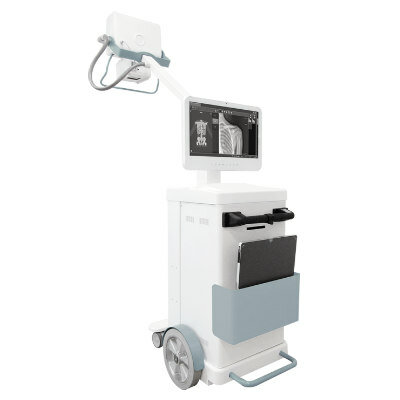3D Imaging System Improves Surgical Suite Efficiency 
|
By MedImaging International staff writers Posted on 08 Apr 2021 |

Image: The OEC 3D system with C-arm (Photo courtesy of GE Healthcare)
A new radiographic system provides precise standard and volumetric interoperative imaging for spinal and orthopedic procedures.
The GE Healthcare (GE; Chicago, IL, USA) OEC 3D is built on GE's OEC Elite C-arm platform, and includes a 31x31 cm CMOS detector designed to provide high resolution images with a field of view large enough to capture L2 to S1 in a single shot. The 200° isocentric sweep creates 3D images with 19x19x19 cm volume and 512³ voxel resolution. In addition to 3D imaging, the system also provides a comprehensive 2D imaging chain, which allows surgical units to store multiple image types within the same patient case for easy reference.
The OEC 3D detailed, fully reconstructed multi-planar 3D images displayed on a 4K ultra high definition (UHD) monitor, all delivered less than 30 seconds after a scan is completed. The GE 3DXR reconstruction engine allows surgeons to analyze the volume reconstructed images quickly and easily with the aid of an advanced visualization package with preferred layouts and views, such as drag and drop, paging, and zoom. Advanced visualization also enables change of perspective views, panning through slices, and adjusting planes in coronal, sagittal, and axial views.
A step-by-step guide is designed to make scanning easy and intuitive by taking users through each stage of 3D scanning, from pre-scan to completion, allowing those with minimal training to complete a scan. For user convenience, familiar OEC icons and interfaces enable control from the C-arm’s OEC Touch, OEC Touch Tableside, remote user interface (RUI), or workstation. The OEC 3D has also been designed to integrate seamlessly with navigation systems, and the open interface architecture is built for future integrations with robotics or AI applications.
“We’re thrilled to introduce OEC 3D to clinicians who want amazing 3D volumetric images quickly during intraoperative procedures,” said Gustavo Perez Fernandez, president and CEO of GE Healthcare Image Guided Therapies. “Built on the successful OEC Elite C-arm platform, the familiar performance and functionality of the OEC 3D C-arm will make 3D imaging routine for complex spine and joint replacement procedures.”
With the rise of minimally invasive procedures such as spinal fusion or lumbar spine scoliosis, seeing all the anatomy of interest, such as cortical rims, pedicle diameters, or orbital floors in fine detail is critical. And complex spine procedures, which include insertion and placement of pedicle screws and prevention or correction of deformities, also require precise views of spinal structures.
The GE Healthcare (GE; Chicago, IL, USA) OEC 3D is built on GE's OEC Elite C-arm platform, and includes a 31x31 cm CMOS detector designed to provide high resolution images with a field of view large enough to capture L2 to S1 in a single shot. The 200° isocentric sweep creates 3D images with 19x19x19 cm volume and 512³ voxel resolution. In addition to 3D imaging, the system also provides a comprehensive 2D imaging chain, which allows surgical units to store multiple image types within the same patient case for easy reference.
The OEC 3D detailed, fully reconstructed multi-planar 3D images displayed on a 4K ultra high definition (UHD) monitor, all delivered less than 30 seconds after a scan is completed. The GE 3DXR reconstruction engine allows surgeons to analyze the volume reconstructed images quickly and easily with the aid of an advanced visualization package with preferred layouts and views, such as drag and drop, paging, and zoom. Advanced visualization also enables change of perspective views, panning through slices, and adjusting planes in coronal, sagittal, and axial views.
A step-by-step guide is designed to make scanning easy and intuitive by taking users through each stage of 3D scanning, from pre-scan to completion, allowing those with minimal training to complete a scan. For user convenience, familiar OEC icons and interfaces enable control from the C-arm’s OEC Touch, OEC Touch Tableside, remote user interface (RUI), or workstation. The OEC 3D has also been designed to integrate seamlessly with navigation systems, and the open interface architecture is built for future integrations with robotics or AI applications.
“We’re thrilled to introduce OEC 3D to clinicians who want amazing 3D volumetric images quickly during intraoperative procedures,” said Gustavo Perez Fernandez, president and CEO of GE Healthcare Image Guided Therapies. “Built on the successful OEC Elite C-arm platform, the familiar performance and functionality of the OEC 3D C-arm will make 3D imaging routine for complex spine and joint replacement procedures.”
With the rise of minimally invasive procedures such as spinal fusion or lumbar spine scoliosis, seeing all the anatomy of interest, such as cortical rims, pedicle diameters, or orbital floors in fine detail is critical. And complex spine procedures, which include insertion and placement of pedicle screws and prevention or correction of deformities, also require precise views of spinal structures.
Latest General/Advanced Imaging News
- New AI Method Captures Uncertainty in Medical Images
- CT Coronary Angiography Reduces Need for Invasive Tests to Diagnose Coronary Artery Disease
- Novel Blood Test Could Reduce Need for PET Imaging of Patients with Alzheimer’s
- CT-Based Deep Learning Algorithm Accurately Differentiates Benign From Malignant Vertebral Fractures
- Minimally Invasive Procedure Could Help Patients Avoid Thyroid Surgery
- Self-Driving Mobile C-Arm Reduces Imaging Time during Surgery
- AR Application Turns Medical Scans Into Holograms for Assistance in Surgical Planning
- Imaging Technology Provides Ground-Breaking New Approach for Diagnosing and Treating Bowel Cancer
- CT Coronary Calcium Scoring Predicts Heart Attacks and Strokes
- AI Model Detects 90% of Lymphatic Cancer Cases from PET and CT Images
- Breakthrough Technology Revolutionizes Breast Imaging
- State-Of-The-Art System Enhances Accuracy of Image-Guided Diagnostic and Interventional Procedures
- Catheter-Based Device with New Cardiovascular Imaging Approach Offers Unprecedented View of Dangerous Plaques
- AI Model Draws Maps to Accurately Identify Tumors and Diseases in Medical Images
- AI-Enabled CT System Provides More Accurate and Reliable Imaging Results
- Routine Chest CT Exams Can Identify Patients at Risk for Cardiovascular Disease
Channels
Radiography
view channel
Novel Breast Imaging System Proves As Effective As Mammography
Breast cancer remains the most frequently diagnosed cancer among women. It is projected that one in eight women will be diagnosed with breast cancer during her lifetime, and one in 42 women who turn 50... Read more
AI Assistance Improves Breast-Cancer Screening by Reducing False Positives
Radiologists typically detect one case of cancer for every 200 mammograms reviewed. However, these evaluations often result in false positives, leading to unnecessary patient recalls for additional testing,... Read moreMRI
view channel
PET/MRI Improves Diagnostic Accuracy for Prostate Cancer Patients
The Prostate Imaging Reporting and Data System (PI-RADS) is a five-point scale to assess potential prostate cancer in MR images. PI-RADS category 3 which offers an unclear suggestion of clinically significant... Read more
Next Generation MR-Guided Focused Ultrasound Ushers In Future of Incisionless Neurosurgery
Essential tremor, often called familial, idiopathic, or benign tremor, leads to uncontrollable shaking that significantly affects a person’s life. When traditional medications do not alleviate symptoms,... Read more
Two-Part MRI Scan Detects Prostate Cancer More Quickly without Compromising Diagnostic Quality
Prostate cancer ranks as the most prevalent cancer among men. Over the last decade, the introduction of MRI scans has significantly transformed the diagnosis process, marking the most substantial advancement... Read moreUltrasound
view channel
Deep Learning Advances Super-Resolution Ultrasound Imaging
Ultrasound localization microscopy (ULM) is an advanced imaging technique that offers high-resolution visualization of microvascular structures. It employs microbubbles, FDA-approved contrast agents, injected... Read more
Novel Ultrasound-Launched Targeted Nanoparticle Eliminates Biofilm and Bacterial Infection
Biofilms, formed by bacteria aggregating into dense communities for protection against harsh environmental conditions, are a significant contributor to various infectious diseases. Biofilms frequently... Read moreNuclear Medicine
view channel
New SPECT/CT Technique Could Change Imaging Practices and Increase Patient Access
The development of lead-212 (212Pb)-PSMA–based targeted alpha therapy (TAT) is garnering significant interest in treating patients with metastatic castration-resistant prostate cancer. The imaging of 212Pb,... Read moreNew Radiotheranostic System Detects and Treats Ovarian Cancer Noninvasively
Ovarian cancer is the most lethal gynecological cancer, with less than a 30% five-year survival rate for those diagnosed in late stages. Despite surgery and platinum-based chemotherapy being the standard... Read more
AI System Automatically and Reliably Detects Cardiac Amyloidosis Using Scintigraphy Imaging
Cardiac amyloidosis, a condition characterized by the buildup of abnormal protein deposits (amyloids) in the heart muscle, severely affects heart function and can lead to heart failure or death without... Read moreImaging IT
view channel
New Google Cloud Medical Imaging Suite Makes Imaging Healthcare Data More Accessible
Medical imaging is a critical tool used to diagnose patients, and there are billions of medical images scanned globally each year. Imaging data accounts for about 90% of all healthcare data1 and, until... Read more
Global AI in Medical Diagnostics Market to Be Driven by Demand for Image Recognition in Radiology
The global artificial intelligence (AI) in medical diagnostics market is expanding with early disease detection being one of its key applications and image recognition becoming a compelling consumer proposition... Read moreIndustry News
view channel
Bayer and Google Partner on New AI Product for Radiologists
Medical imaging data comprises around 90% of all healthcare data, and it is a highly complex and rich clinical data modality and serves as a vital tool for diagnosing patients. Each year, billions of medical... Read more





















